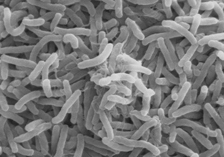Erin Chapman

In the developed world, the closest most of us have come to cholera is either through Oprah-endorsed magical realism or disappointment on the Apple IIe Oregon Trail – “Chelsea has died of cholera.” But this acute infection breaks out in over 50 countries each year, largely in nations where access to basic sanitation and clean drinking water cannot be assured.
Cholera is caused by ingestion of the bacterium Vibrio cholerae. When a person consumes infected food or water, the cholera bacteria attach themselves to the small intestine and begin multiplying. (Personally, I’ve had a similar situation with relatives playing the role of bacteria and my couch playing the role of the small intestine.). Once they’re comfortably settled in, the bacteria begin producing a toxin that causes the cells lining the intestinal walls to secrete massive amounts of fluid. (And here the houseguest analogy ceases to be relevant.) This intense fluid loss causes — in the words of the WHO – “copious, painless, watery diarrhoea.” Really, though, is copious, watery diarrheoa ever truly painless? The resulting dehydration can be severe and death can occur if treatment is not administered promptly. In the most serious cases, 10 to 15% of total body weight can be lost in a matter of hours.
The bacteria can be spread through contact with infected stool or vomit or through contaminated food or water supplies. Surprisingly, most people infected with cholera don’t experience symptoms, although the bacteria is present in their system for 7-14 days. Of those who do get sick, less than 20% develop the moderate or severe dehydration that causes the most serious problems.
Records of the illness probably date back to the time of the classical physicians Hippocrates and Galen who described afflictions with symptoms similar to cholera. The word itself is from the Greek “khole,” meaning either “bile” or the more anatomically descriptive “drainpipe.” (TMI Dr. Hippocrates, TMI.) The first outbreak in modern history appeared in the early 19th century in the Ganges delta and spread to the rest of the world. Six more pandemics followed in the ensuing years, killing millions of people. The last of those is ongoing and has been spreading from South Asia to Africa and the Americas since 1961. In 2006, the number of cholera cases reported to the WHO was 236,896 — an increase of 79% from the previous year. Some studies have indicated that global warming might be contributing to the spread of the bacteria. Perhaps if we could splice the genes of cholera and a polar bear we could balance out this whole biodiversity upheaval thing. That, or produce one really awesome straight-to-DVD movie.
Despite the fact that cholera is easily treatable, its impact on the developing world is serious. Only a small percentage of cases — less than 10% — are reported to the WHO, making it difficult to track paths of transmission. Cholera vaccines are available, but the surest method to prevent the bacteria’s spread is through basic sanitation. Infected patients are treated through a method similar to my favorite hangover solution – rehydration. Basically, patients are given an oral solution that’s a mixture of glucose and electrolytes. For those who are vomiting too severely to drink, intravenous drips are used.
Unfortunately, in addition to the human toll wrought by cholera, economic costs are often a byproduct of an outbreak. When word of an epidemic hits, stricken countries often face travel and import/export restrictions from other nations. A 1991 outbreak in Peru is estimated to have cost the country $770 million in trade and tourism. I guess in Zimbabwe dollars that might buy you, what, a can of beans?
(Sources: CDC, Doctors Without Borders, FDA, WHO)
